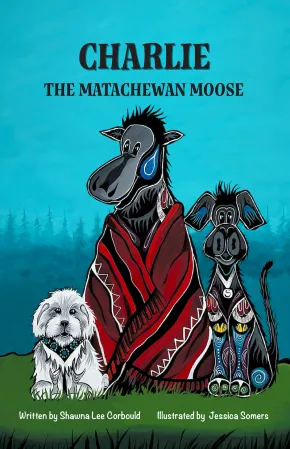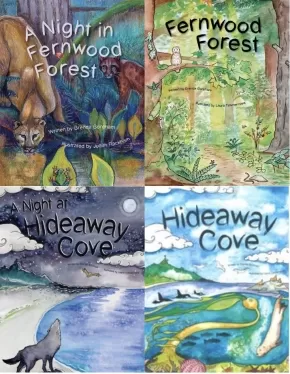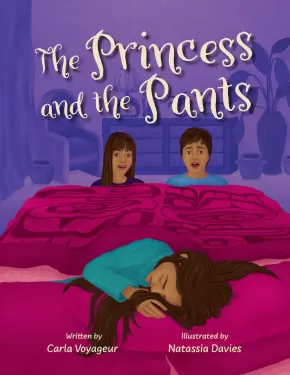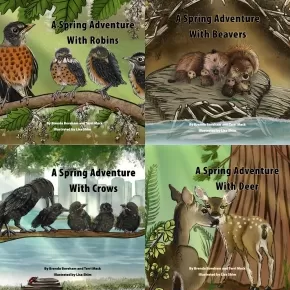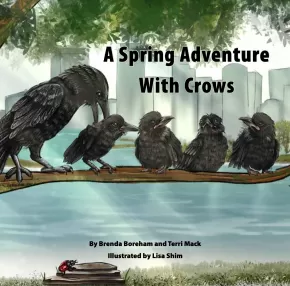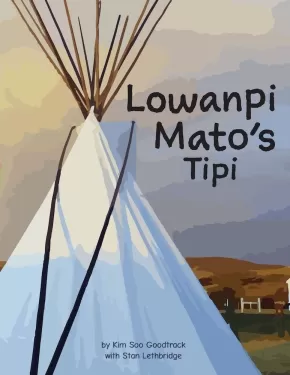
Grade 2
1
-
15
of
89 Results;
Sort By
Go To
of 6
Celebrating Potlatches
$21.95
Artists:
Format:
Hardcover
Text Content Territories:
Indigenous Canadian; First Nations; Tsimshian (Ts'msyen); Nisga'a;
ISBN / Barcode: 9781771746564
Synopsis:
Synopsis:
“Papa, what is a Potlatch?”
Inspired by Ts’msyen Chief William Beynon’s historic notebooks on Potlatches in the Gitxsan village of Gitsegukla, Celebrating Potlatches pairs intergenerational storytelling with beautiful illustrations to honour Indigenous traditions. From the award-winning author of Oolichan Moon and the accomplished illustrator of Be a Good Ancestor, this book recounts the 1885 Potlatch ban and the resilience of the communities who fought to keep their traditions alive.
Reviews
“Heartfelt and timely, Celebrating Potlatches gifts readers with cultural teachings through an intergenerational account of Indigenous resilience. This book is a beautiful tribute to the author’s great-grandfather, William Beynon, whose life’s work documenting oral histories of Sm’algya̱x-speaking Peoples and their Potlatches continues to be foundational to our cultural resurgence today.” – Sm Łoodm ‘Nüüsm (Dr. Mique’l Dangeli), Sm’algya̱x language expert and Assistant Professor of Indigenous Arts at the University of Victoria
“This beautiful book shares the importance of community, culture, and identity. As you make your way through the pictures and words, they bring you to an understanding of how important the Potlatch ceremony was and continues to be for Indigenous Peoples.” – Carolyn Roberts, educator, speaker, and author of Re-Storying Education
Educator Information
Recommended for ages 4 to 8.
Through this conversational historic account, readers can learn alongside the narrator as his Papa shares his wisdom about the rich history of the Potlatch.
Curriculum Connections
- Early literacy – listening, reading, and discussing
- Art – traditional Indigenous art, drumming, and regalia
- Social studies – the 1885 Potlatch ban, history of Indigenous Peoples, connection to community
- Social responsibility – uplifting ourselves and others, honouring traditions
- Indigenous knowledge and traditions – traditional teachings, Potlatch ceremonies, intergenerational storytelling
Two free, downloadable lesson plans—one for kindergarten to Grade 1 and one for Grades 2 to 3—provide connections to Social Studies curriculum.
Additional Information
32 Pages | 10" x 8.5" | Hardcover
Charlie the Matachewan Moose
 $14.95
$14.95

Artists:
Format:
Paperback
Text Content Territories:
Indigenous Canadian; First Nations; Anishinaabeg; Ojibway; Matachewan First Nation;
ISBN / Barcode: 9781771746342
Synopsis:
Synopsis:
There, in the middle of the forest, the young calf stood alone.
When a young moose calf gets lost in a storm, he is found by Nana and Papa, a kind couple who offer him shelter and a name: Charlie. They bring him home to Matachewan First Nation, where two dogs, Spike and Molly, happily welcome him into their pack. Together, Charlie and his friends spend their days digging holes on the beach, playing fetch, and having fun.
But Charlie is growing fast, and soon it will be time for him to return to the forest. With Spike and Molly by his side, Charlie sets off on an adventure to learn more about himself—and what it means to be a moose.
Educator Information
This illustrated chapter book is recommended for ages 6 to 9.
Flesch-Kincaid Grade Level: 2.9
The chapters are each titled with an Ojibwe word or phrase, and a glossary of the Ojibwe words and their pronunciations is included at the back of the book. Discussion questions and an author’s note can also be found at the end of the book, and a free lesson plan is available for download on our website.
With an engaging story, lovable characters, and powerful messages, Charlie the Matachewan Moose is perfect for readers transitioning from picture books to chapter books. Meaningful themes of identity and self-awareness provide opportunities for discussion, making this book an excellent choice for homes and classrooms.
Curriculum Connections
- English Language Arts – figures of speech, reading, listening, discussing
- Science – diverse ecosystems, animal behaviours and habitats
- Personal and Social Awareness – personal and cultural identity, connecting to community, identifying values
- Art – traditional Indigenous art styles
- Social-Emotional Learning – recognizing and managing emotions, building positive relationships, showing empathy
- Indigenous Knowledge and Traditions – Ojibwe language and teachings, cultural significance of animals
Additional Information
112 Pages | 5.5” x 8.5” | Paperback | Printed in Canada
A Night in Fernwood Forest
 $21.95
$21.95

Artists:
Format:
Hardcover
ISBN / Barcode: 9781771746021
Synopsis:
Synopsis:
Come with us for a walk along a secluded forest trail on a quiet night in May. We catch glimpses of ten animals as they move about in their woodland home from dusk until dawn. A mother cougar and her cub, a colony of bats, and a family of shrews are among the nighttime creatures we encounter. Beautiful full-page illustrations also depict many plants that live in this ecosystem. Information at the back of the book provides facts about nurse logs and the Pacific Northwest temperate rainforest.
A Night in Fernwood Forest is part of the By Day and By Night Nature Series. Books in this series focus on a specific habitat and explore the many connections within a healthy ecosystem. Through lyrical stories, supportive illustrations, labelled diagrams, and nature notes, readers learn about living and non-living parts of the ecosystem.
Additionally, readers can:
- use a picture clue on each page to predict the animal featured on the next page
- count animals as their numbers increase in each illustration
- search for an animal that travels from page to page
- discover patterns in the text and structure of each book
- track the movement of the sun or moon across the sky
Reviews
"Brenda Boreham brings her teaching experience and love of nature to these books, filling them with opportunities for the discovery of interactions between plants and animals in healthy ecosystems…. This beautiful book will engage listeners and independent readers and support the science goals in elementary school classrooms." – Canadian Teacher Magazine, Winter 2024 issue
Educator & Series Information
Recommended for kindergarten to grade 4.
This is a fictional story with factual information about the Pacific Northwest temperate rainforest.
Search for a moth that travels from page to page in this story!
Each book in the By Day and By Night Nature Series focuses on a scene typical of a distinct west coast habitat, showing how living and non-living things are connected in a healthy ecosystem. As readers, we observe animals going about their daily activities: caring for their young, searching for food, and responding to the changes in light, temperature, and weather conditions throughout the day or night. The last four pages of each book provide facts about the highlighted animals and plants as well as features that are unique to their habitats. The final page suggests ways that young readers and their families can be respectful as they visit wilderness areas.
Readers with a sense of curiosity will find opportunities in these books to:
- use picture clues to predict the featured animal on the next page
- identify, count, and sequence numbers (1 owl, 2 deer, 3 squirrels, etc.)
- search for small creatures that travel from page to page
- discover patterns in the text and structure of the books
- track the movement of the sun, or moon, across the sky
Curriculum Links
Reading - Providing opportunities for guided practise in using reading strategies: visualizing, making connections, asking questions, transforming, and inferring.
Science - Supporting discussion and further exploration:
- characteristics of living things
- needs of living things
- connections between living and non-living things
- daily and seasonal changes
- animal growth and changes
- plant growth and changes
- weather
- habitats
- observable patterns in the sky
Numeracy - Counting and sequencing of numbers 1 to 10.
Social Responsibility - Initiating discussions about ways to take care of wilderness areas.
Additional Information
32 Pages | 8.5" x 11" | Hardcover | ISBN: 9781771746021
32 Pages | 8.5" x 11" | Hardcover | ISBN: 9781771746021
By Day and By Night Nature Series Bundle
 $72.32 $80.35
$72.32 $80.35

ISBN / Barcode: 9781771746014
Synopsis:
Synopsis:
This bundle includes all four titles in the By Day and By Night Nature Series:
- Hideaway Cove (hardcover)
- A Night at Hideaway Cove (paperback)
- Fernwood Forest (hardcover)
- A Night in Fernwood Forest (hardcover)
Each book in the By Day and By Night Nature Series focuses on a scene typical of a distinct west coast habitat, showing how living and non-living things are connected in a healthy ecosystem. As readers, we observe animals going about their daily activities: caring for their young, searching for food, and responding to the changes in light, temperature, and weather conditions throughout the day or night. The last four pages of each book provide facts about the highlighted animals and plants as well as features that are unique to their habitats. The final page suggests ways that young readers and their families can be respectful as they visit wilderness areas.
Readers with a sense of curiosity will find opportunities in these books to:
- use picture clues to predict the featured animal on the next page
- identify, count, and sequence numbers (1 owl, 2 deer, 3 squirrels, etc.)
- search for small creatures that travel from page to page
- discover patterns in the text and structure of the books
- track the movement of the sun, or moon, across the sky
Reading Level: Nonfiction text features such as headings, bold words, bullets, captions, and labelled diagrams make these books accessible to independent readers in grades 2 to 4. The books would also be great “read-alouds” for younger children.
Curriculum Links
Reading - Providing opportunities for guided practise in using reading strategies: visualizing, making connections, asking questions, transforming, and inferring.
Science - Supporting discussion and further exploration:
- characteristics of living things
- needs of living things
- connections between living and non-living things
- daily and seasonal changes
- animal growth and changes
- plant growth and changes
- weather
- habitats
- observable patterns in the sky
Numeracy - Counting and sequencing of numbers 1 to 10.
Social Responsibility - Initiating discussions about ways to take care of wilderness areas.
Lesson plans are available for each book and are free to download from each book's listing on our website!
Additional Information
Titles included are 32 pages, 8.5" x 11"
Please note: All books in this bundle are hardcovers, except for A Night at Hideaway Cove, which is a paperback as the hardcover edition is out of print.
Powwow Dancing With Family (PB)
 $16.95
$16.95

Artists:
Format:
Paperback
Text Content Territories:
Indigenous Canadian; First Nations; Salish; Interior Salish; Secwepemc (Shuswap);
ISBN / Barcode: 9781771746281
Synopsis:
Synopsis:
Drumming, singing, and dancing are all part of being at a Powwow. Perry and his family travel all over North America to participate in these family and community gatherings. Join Perry’s two boys as they share their treasured memories of being at Powwows with their family and learning how to dance.
Reviews
“Lavishly illustrated with photographs, vivid sketches, and ledger art, Powwow Dancing With Family provides a detailed description of each stage of the Powwow, historical and contemporary aspects of the Powwow, and pays homage to Indigenous culture and customs. This informative resource will support studies of Indigenous culture, history, traditions, community, art, and family lifestyle.” – ERAC Review, May 2019
Educator Information
Includes three pages of educational material on Powwows with information found under these headings:
- What is a Powwow?
- Powwow Regalia
- Powwow Dances
About Perry Smith's Ledger Art:
Ledger Art is an art form that was developed in the mid 1800s to early 1900s by the Plains First Nations during a time when reserves were being established across North America. The ledger books were acquired in trade, war, or raids. New art supplies were also introduced: coloured pencils, crayons, and occasionally water paints. The new supplies were favoured by artists over the traditional bone and stick brushes. Many of the artworks within these ledger books display a traditional way of life, before assimilation. Today these artworks are greatly valued for the historical perspective that they offer.
Additional Information
32 pages | 8" x 8" | ISBN: 9781771746281 | Paperback
The Princess and the Pants
 $19.95
$19.95

Artists:
Format:
Hardcover
Text Content Territories:
Indigenous Canadian; First Nations; Kwakwaka'wakw (Kwakiutl); Musgamagw Dzawada’enuxw;
ISBN / Barcode: 9781771746038
Synopsis:
Synopsis:
On the banks of the Gwa’yi River, a young Dzawada̱ʼenux̱w princess grows up to be a curious student, an influential leader, and a mother. She is a humble person and doesn’t speak of her royalty to her children, but when they learn she is a princess at a traditional celebration, they are in disbelief. She doesn’t wear fancy clothes or attend balls or do anything the children think princesses should do. Using a strategy they had read about in an old tale to put their mother’s royalty to the test, the children discover the truth. But more importantly, they also learn what it really means to be a princess.
Written as a tribute to the author’s grandmother, this beautifully illustrated story reimagines a fairy tale in a contemporary Indigenous setting.
Awards
- First Place: 2025 Sunshine Coast Writers and Editors Society Book Awards for BC Authors
- Longlisted: 2024-2025 First Nation Communities READ Award
Reviews
“Loved the role modelling of the princess as one who represents adventure, cultural knowledge, and caring for others while finding achievement. The story promotes respect, admiration, humility, kindness, and honouring of a strong, successful female. The imaginative story is a fun challenge to princess stereotypes and classic related fairytales. The nonfiction content provides an enriching and personalized bonus that deepens the impact of the words and provides local significance.…. The illustrations are excellent, offering accurate and attractive cultural designs, clothing, headwear, and jewellery.” – The 2025 Sunshine Coast Writers and Editors Society judges’ panel
"A contemporary Indigenous spin on The Princess and the Pea, the picture book is suitable as a part of a fairy tale unit and a read-aloud to spark discussions about personal qualities and attributes, expectations, stereotypes, curiosity, the importance of helping others, and honouring traditions." – Focused Education Resources
Educator Information
Recommended for ages 4 to 8.
Backmatter provides details about Ukwanalis, including a map, as well as information about the inspiration behind the story, Dr. Evelyn Voyageur.
Curriculum Connections
- Early Literacy – listening, reading, and discussing
- Art – traditional Indigenous art practices, including jewellery and regalia
- Social Studies – career education, family history, connection to community, geography, and local First Peoples communities
- Language Arts – contemporary First Peoples stories and revisioning classic fairy tales
- Social Responsibility – leadership, humility, caring for others, and honouring traditions
Additional Information
24 Pages | 8.5” x 11” | Hardcover | 9781771746038
Animals Care for Mother Earth: A Teaching Resource for Personal Development
$16.95
Artists:
Format:
Paperback
Text Content Territories:
Indigenous Canadian; First Nations; Tsimshian (Ts'msysen);
ISBN / Barcode: 9781771745970
Synopsis:
Synopsis:
Animals Care for Mother Earth comprises six contemporary, interrelated stories and supporting resources for teachers. In the first story, animals cooperate to clean up a polluted pond. In subsequent stories, they care for each other in the aftermath of the pollution problem, demonstrating strength of character and social responsibility. This book can be used in elementary schools to teach—through storytelling—the value of personal strengths and community supports while incorporating Tsimshian language and knowledge into classroom lessons. It also provides many opportunities to extend the learning to other curriculum areas, including science, math, reading, writing, social studies, and art.
Reviews
"This teaching resource uses storytelling as a way to impart knowledge and initiate discussions and activities that support social and emotional learning.” – Canadian Teacher Magazine, Spring 2023 issue
Educator Information
Recommended for use with grades 1 to 6 (elementary students).
Everything educators need is included in this single work -- contemporary Indigenous stories to read aloud and explore with students, as well as story guides, a map, plant information pages, suggestions for classroom activities, discussion questions, inquiry activities, talking together points, information to support intergenerational or peer-to-peer learning, and connections to the Core Competencies and social and emotional learning (SEL) competencies.
Find a bundle for Animals Care for Mother Earth that includes the book and learning environment resources HERE!
Additional Information
32 Pages | 8.5" x 11" | ISBN: 9781771745970 | Paperback
Fernwood Forest
 $21.95
$21.95

Artists:
Format:
Hardcover
ISBN / Barcode: 9781771745994
Synopsis:
Synopsis:
Join us on a bright, sunlit day in the middle of May as we wander the quiet trails of a secluded woodland. Here, we catch glimpses of the daily activities of many creatures—from a pair of black-tailed deer to a colony of carpenter ants—that make Fernwood Forest their home. We also learn about the three layers of the Pacific Northwest temperate rainforest and explore interesting facts about forest plants and animals.
Fernwood Forest is part of the By Day and By Night Nature Series. Books in this series focus on a specific habitat and explore the many connections within a healthy ecosystem. Through lyrical stories, supportive illustrations, labelled diagrams, and nature notes, readers learn about living and non-living parts of the ecosystem.
Additionally, readers can:
-
use a picture clue on each page to predict the animal featured on the next page
-
count animals as their numbers increase in each illustration
-
search for an animal that travels from page to page
-
discover patterns in the text and structure of each book
-
track the movement of the sun or moon across the sky
Educator & Series Information
Recommended for kindergarten to grade 4.
This is a fictional story with factual information about the Pacific Northwest temperate rainforest.
Search for a bee that travels from page to page in this story!
Each book in the By Day and By Night Nature Series focuses on a scene typical of a distinct west coast habitat, showing how living and non-living things are connected in a healthy ecosystem. As readers, we observe animals going about their daily activities: caring for their young, searching for food, and responding to the changes in light, temperature, and weather conditions throughout the day or night. The last four pages of each book provide facts about the highlighted animals and plants as well as features that are unique to their habitats. The final page suggests ways that young readers and their families can be respectful as they visit wilderness areas.
Readers with a sense of curiosity will find opportunities in these books to:
- use picture clues to predict the featured animal on the next page
- identify, count, and sequence numbers (1 owl, 2 deer, 3 squirrels, etc.)
- search for small creatures that travel from page to page
- discover patterns in the text and structure of the books
- track the movement of the sun, or moon, across the sky
Curriculum Links
Reading - Providing opportunities for guided practise in using reading strategies: visualizing, making connections, asking questions, transforming, and inferring.
Science - Supporting discussion and further exploration:
- characteristics of living things
- needs of living things
- connections between living and non-living things
- daily and seasonal changes
- animal growth and changes
- plant growth and changes
- weather
- habitats
- observable patterns in the sky
Numeracy - Counting and sequencing of numbers 1 to 10.
Social Responsibility - Initiating discussions about ways to take care of wilderness areas.
Additional Information
32 Pages | 8.5" x 11" | Hardcover | ISBN: 9781771745994
32 Pages | 8.5" x 11" | Hardcover | ISBN: 9781771745994
Me and My Community: Activity Book
$10.95
Artists:
Format:
Paperback
Text Content Territories:
Indigenous Canadian; First Nations; Kwakwaka'wakw (Kwakiutl);
ISBN / Barcode: 9781771740586
Synopsis:
Synopsis:
Formerly titled On My Walk, this activity book, Me and My Community, has been revised and updated to include new activities, new colouring pages, and more writing prompts.
Additional Information
24 Pages | ISBN: 9781771740586
A Spring Adventure Series Bundle
 $43.02 $47.80
$43.02 $47.80

ISBN / Barcode: 9781771745734
Synopsis:
Synopsis:
Included in this bundle are all four titles in the A Spring Adventure series:
A Spring Adventure With Deer
A Spring Adventure With Crows
A Spring Adventure With Robins
A Spring Adventure With Beavers
Books in this series use both fiction and non-fiction as a unique approach to storytelling.
On left-hand pages, lyrical text and colourful illustrations tell stories of young animals and their early morning spring adventures. Expertly woven into these delightful stories are interesting facts about the young animals and other plants and animals in that ecosystem.
Captioned and labelled photographs, word boxes, a diagram, and a map make the non-fiction portion of these books an accessible source of information for young readers.
Science Connections: Biodiversity, animal classification, food chains, life cycles, ecosystems, geology, and the connections between living and non-living things are some of the concepts included in this book.
Recommended for grades 2 and 3.
Scroll below to learn more about each book included in this bundle.
Additional Information
ISBN: 9781771745734
A Spring Adventure With Beavers
 $11.95
$11.95

Artists:
Format:
Paperback
ISBN / Barcode: 9781771745673
Synopsis:
Synopsis:
“The kit uses her webbed back feet and little flat tail to push through the water. She swims down the tunnel and out into the pond. At the surface of the water, she sees a dragonfly. She follows it to the edge of the pond. It settles on a big rock.”
This book uses both fiction and non-fiction as a unique approach to storytelling.
On left-hand pages, lyrical text and colourful illustrations tell a story of a young beaver’s early morning spring adventure. Using her senses, the kit discovers the world around her lodge. Expertly woven into this delightful story are interesting facts about beavers and other plants and animals in this wetland ecosystem.
Captioned and labelled photographs, word boxes, a diagram, and a map make the non-fiction portion of this book an accessible source of information for young readers.
Educator & Series Information
This book is part of the A Spring Adventure series.
Recommended for grades 2 and 3.
Captioned and labelled photographs, word boxes, a diagram, and a map make the non-fiction portion of this book an accessible source of information for young readers.
Science Connections: Biodiversity, animal classification, food chains, life cycles, ecosystems, geology, and the connections between living and non-living things are some of the concepts included in this book.
Additional Information
24 Pages | 8" x 8" | ISBN: 978-1-77174-567-3 | Paperback
A Spring Adventure With Crows
 $11.95
$11.95

Artists:
Format:
Paperback
ISBN / Barcode: 9781771745680
Synopsis:
Synopsis:
“The fledgling lands safely at the foot of the tree. He looks around. He sees a ladybug crawling along the leaf of a stinging nettle. He is curious. Is it good to eat? He hops up onto a smooth, black rock to take a closer look.”
This book uses both fiction and non-fiction as a unique approach to storytelling.
On left-hand pages, lyrical text and colourful illustrations tell a story of a young crow’s early morning spring adventure. Using his senses, the fledgling discovers the world around his nest. Expertly woven into this delightful story are interesting facts about crows and other plants and animals in a city park.
Captioned and labelled photographs, word boxes, a diagram, and a map make the non-fiction portion of this book an accessible source of information for young readers.
Educator & Series Information
This book is part of the A Spring Adventure series.
Recommended for grades 2 and 3.
Captioned and labelled photographs, word boxes, a diagram, and a map make the non-fiction portion of this book an accessible source of information for young readers.
Science Connections: Biodiversity, animal classification, food chains, life cycles, ecosystems, geology, and the connections between living and non-living things are some of the concepts included in this book.
Additional Information
24 Pages | 8" x 8" | ISBN: 978-1-77174-568-0 | Paperback
A Spring Adventure With Deer
 $11.95
$11.95

Artists:
Format:
Paperback
ISBN / Barcode: 9781771745659
Synopsis:
Synopsis:
“The buzzing sound fades away when the bee flies off. The fawn twitches his large ears and looks about. He can hear trickling water close by. He walks to the far side of the meadow, down a rocky bank, and to a little creek below.”
This book uses both fiction and non-fiction as a unique approach to storytelling.
On left-hand pages, lyrical text and colourful illustrations tell a story of a young fawn’s early morning spring adventure. Using his senses, the fawn discovers the world around him while searching for his mother. Expertly woven into this delightful story are interesting facts about black-tailed deer and other plants and animals in a forest ecosystem.
Captioned and labelled photographs, word boxes, a diagram, and a map make the non-fiction portion of this book an accessible source of information for young readers.
Educator & Series Information
This book is part of the A Spring Adventure series.
Recommended for grades 2 and 3.
Captioned and labelled photographs, word boxes, a diagram, and a map make the non-fiction portion of this book an accessible source of information for young readers.
Science Connections: Biodiversity, animal classification, food chains, life cycles, ecosystems, geology, and the connections between living and non-living things are some of the concepts included in this book.
Additional Information
24 Pages | 8" x 8" | ISBN: 978-1-77174-565-9 | Paperback
A Spring Adventure With Robins
 $11.95
$11.95

Artists:
Format:
Paperback
ISBN / Barcode: 9781771745666
Synopsis:
Synopsis:
“The fledgling lands in the dry leaves, cones, and twigs on the forest floor. He stops for a moment. He looks around. He is wondering about the little flowers on the kinnikinnick plants. Are they food? He hops up onto a nearby rock to take a closer look.”
This book uses both fiction and non-fiction as a unique approach to storytelling.
On left-hand pages, lyrical text and colourful illustrations tell a story of a young robin’s early morning spring adventure. Using his senses, the fledgling discovers the world around his nest. Expertly woven into this delightful story are interesting facts about robins and other plants and animals in a forest ecosystem.
Captioned and labelled photographs, word boxes, a diagram, and a map make the non-fiction portion of this book an accessible source of information for young readers.
Educator & Series Information
This book is part of the A Spring Adventure series.
Recommended for grades 2 and 3.
Captioned and labelled photographs, word boxes, a diagram, and a map make the non-fiction portion of this book an accessible source of information for young readers.
Science Connections: Biodiversity, animal classification, food chains, life cycles, ecosystems, geology, and the connections between living and non-living things are some of the concepts included in this book.
Additional Information
24 Pages | 8" x 8" | ISBN: 978-1-77174-566-6 | Paperback
Lowanpi Mato’s Tipi
 $18.50
$18.50

Artists:
Format:
Hardcover
Text Content Territories:
Indigenous Canadian; First Nations; Sioux; Lakota;
ISBN / Barcode: 9781771744751
Synopsis:
Synopsis:
“Hokahe! Welcome!”
Welcome to Wood Mountain, home of the Lakota People, in southern Saskatchewan. It is here that we meet Stan Lethbridge, whose ancestral name is Lowanpi Mato (Singing Bear).
Join Lowanpi Mato as he prepares to set up his summer Tipi. He shares with us Lakota life values and traditions, and how they connect to building and taking care of a Tipi. He teaches us that to build a Tipi you need many items; some are from natural sources and others are purchased from a store. Lowanpi Mato takes us through a step-by-step building process so that we can all learn how a Tipi is built.
The Lakota language is woven throughout the story. The Lakota counting chart on pages 30 and 31 invites you to learn to count and have some fun looking back through the book to find items that match each number.
Welcome to Wood Mountain, home of the Lakota People, in southern Saskatchewan. It is here that we meet Stan Lethbridge, whose ancestral name is Lowanpi Mato (Singing Bear).
Join Lowanpi Mato as he prepares to set up his summer Tipi. He shares with us Lakota life values and traditions, and how they connect to building and taking care of a Tipi. He teaches us that to build a Tipi you need many items; some are from natural sources and others are purchased from a store. Lowanpi Mato takes us through a step-by-step building process so that we can all learn how a Tipi is built.
The Lakota language is woven throughout the story. The Lakota counting chart on pages 30 and 31 invites you to learn to count and have some fun looking back through the book to find items that match each number.
Educator Information
Lakota language is woven throughout this story, as are the seven values of Lakota life.
Lakota language is woven throughout this story, as are the seven values of Lakota life.
Includes a counting chart from 1 to 20 in Lakota, as well as a search-and-find counting game.
Additional Information
32 pages | 8.5" x 11" | Hardcover | ISBN: 9781771744751
32 pages | 8.5" x 11" | Hardcover | ISBN: 9781771744751
Sort By
Go To
of 6




